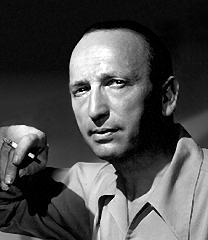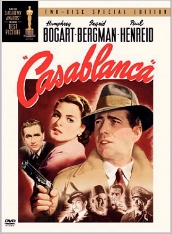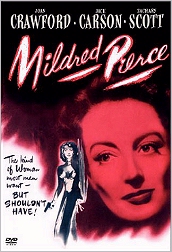 On Friday, July 3, 1942, there was a party on the set of Casablanca to celebrate Michael Curtiz's fifteen years at Warner Brothers. Shooting stopped more than half an hour early, and Jack Warner and Hedda Hopper, the industry's second-most-important gossip columnist, were among the guests. Five years later, to commemorate Curtiz's twentieth anniversary, Warner published a "For the Love of Mike" letter in the Hollywood trade papers. The advertisement praised Curtiz's decision to spend a second twenty years at Warner Bros. But only six years after that, Curtiz had a bitter fight with Warner Bros. over money and left the studio.
On Friday, July 3, 1942, there was a party on the set of Casablanca to celebrate Michael Curtiz's fifteen years at Warner Brothers. Shooting stopped more than half an hour early, and Jack Warner and Hedda Hopper, the industry's second-most-important gossip columnist, were among the guests. Five years later, to commemorate Curtiz's twentieth anniversary, Warner published a "For the Love of Mike" letter in the Hollywood trade papers. The advertisement praised Curtiz's decision to spend a second twenty years at Warner Bros. But only six years after that, Curtiz had a bitter fight with Warner Bros. over money and left the studio.
Yankee Doodle Dandy (1942), Curtiz's biography of George M. Cohan, was the big movie that summer, artistically and commercially, and Hopper wondered how Curtiz could successfully make such an American picture. He answered that maybe because he had seen so many people without liberties he loved to do American stories. Curtiz and his boyhood friend Alexander Korda had both fled from the counter-revolutionary, anti-Semitic Horthy regime in Hungary in 1919 (where Curtiz had directed over a hundred silent films). The two men spent hours fighting over the merits of England, where Korda had settled, and America.
Hal Wallis told his biographer that Curtiz was the most cantankerous of the Warner Bros, directors, that he fought with everyone, and that a day on a Curtiz set seemed to be nothing but quarrels and irascibility. And yet, Wallis said, when he sat and watched the rushes from each quarrelsome day, he discovered that an alchemy had taken place. The camera never shows off in Casablanca, never preens and calls attention to itself, although, as always, Curtiz carefully composed each shot. It was Curtiz's ability to compose exciting action that made a star of Errol Flynn. From Flynn's first major role in Captain Blood in 1935 through The Charge of the Light Brigade (1936), The Adventures of Robin Hood (1938), and The Sea Hawk (1940), Curtiz created a huge canvas tailored to the limited talents of the actor.
 Humphrey Bogart's feelings about Curtiz were mixed. "He thought the way Curtiz used a camera was brilliant," says Lauren Bacall. In the aftermath of Casablanca, when Bogart signed a fifteen-year contract in 1946 that gave him director approval, Curtiz was one of five directors Bogart preapproved. The other four were John Cromwell, Delmer Daves, Howard Hawks, and John Huston. But Bogart, who had ended up as a crooked fight promoter, a crooked lawyer, and a gold thief in his three previous Curtiz movies--Kid Galahad (1937), Angels with Dirty Faces (1938), and Virginia City (1940)--also resented Curtiz's lack of interest in actors. Lee Katz remembers Bogart and Bette Davis stopping in the middle of a scene during the filming of Kid Galahad. "They were furious as hell because Mike was not watching what they were doing. He was watching the movements of the dolly."
Humphrey Bogart's feelings about Curtiz were mixed. "He thought the way Curtiz used a camera was brilliant," says Lauren Bacall. In the aftermath of Casablanca, when Bogart signed a fifteen-year contract in 1946 that gave him director approval, Curtiz was one of five directors Bogart preapproved. The other four were John Cromwell, Delmer Daves, Howard Hawks, and John Huston. But Bogart, who had ended up as a crooked fight promoter, a crooked lawyer, and a gold thief in his three previous Curtiz movies--Kid Galahad (1937), Angels with Dirty Faces (1938), and Virginia City (1940)--also resented Curtiz's lack of interest in actors. Lee Katz remembers Bogart and Bette Davis stopping in the middle of a scene during the filming of Kid Galahad. "They were furious as hell because Mike was not watching what they were doing. He was watching the movements of the dolly."
Curtiz's vision of any movie, including Casablanca was almost totally a visual one. "Once," says Lee Katz, "and I've forgotten what picture this was on, the master shot had a grand piano prominently in the foreground. And when Mike moved into a reverse shot, he said, 'Take out the piano,' And I said, 'Mike, isn't somebody going to say, Where's the piano?' And he said, 'Believe me, if anybody asks, Where's the piano?, they're not watching the picture.'" Howard Koch wrote several movies for Curtiz, and whenever he complained that Curtiz was making a character behave illogically Curtiz would brush him off with "Who cares about character? I make it go so fast nobody knows."
 Curtiz's career went downhill after Mildred Pierce in 1945 and Life With Father in 1947. After a postwar boom that brought the studios peak profits in 1946 and good revenues in 1947, the movie industry went downhill, too, a victim of television and the government antitrust suit that forced the studios to divorce themselves from their theaters and to sell their movies on a picture-by-picture basis.
Curtiz's career went downhill after Mildred Pierce in 1945 and Life With Father in 1947. After a postwar boom that brought the studios peak profits in 1946 and good revenues in 1947, the movie industry went downhill, too, a victim of television and the government antitrust suit that forced the studios to divorce themselves from their theaters and to sell their movies on a picture-by-picture basis.
In the late forties, Curtiz formed a corporation to make movies for Warner Bros. He would put up 30 percent of the production costs and get 30 percent of the profits. But Curtiz had lost his box-office touch. Warners claimed that only one of Curtiz's eleven films, I'll See You in My Dreams (1951), had made a profit and that the others--including Lady Takes a Sailor (1949), Bright Leaf (1950), and his remake of The Jazz Singer (1953)--had lost a total of $4.6 million.
Curtiz died of cancer in 1962. The cancer had been diagnosed six or seven years before he died, but the family doctor did not tell him the truth. "Mike found out after he fell when he was directing his last movie, The Comancheros (1961)," says his stepson, John Meredyth Lucas. "When he was x-rayed, the bone looked like lacework. That was maybe six months or a year before he died. When Mike went to the doctor and asked why he hadn't been told, the doctor said, 'How many pictures have you made since your operation?' Mike said, 'Seven or eight.' 'How many do you think you would have made?' And Mike said, 'You're right.'"
When he died in 1962, Michael Curtiz was, according to most of the obituaries, seventy-two years old. He may have been older. "Mike would never tell us his age," says his stepson. "When they went to get passports and my mother saw Mike's age, she said, 'But it says you're ten years younger than I am.' And Mike said, 'Darling, it's simple. You lie.'" By the time he died, he had directed more than 150 movies.
--ALJEAN HARMETZ, from The Making Of
Casablanca, 1992.